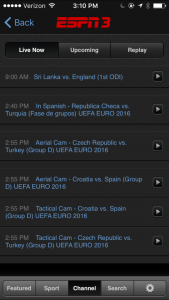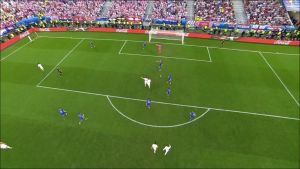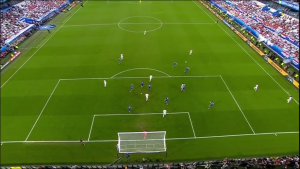ESPN Streams Multiscreen Excitement From EURO 2016
Viewers enjoying a true second-screen multi-stream experience with four alternate feeds
Story Highlights
Soccer fans have enjoyed a flood of high-level international gameplay in the past weeks, thanks to the work ESPN has done broadcasting cable and online coverage of the UEFA EURO 2016 tournament.
The tournament consists of 51 games, which are delivered by ESPN, ESPN2, and WatchESPN/ESPN3. Fans can enjoy a true second-screen multi-stream experience with four alternate feeds — a Spidercam, Spidercam triple-box, Tactical Cam, and Tactical Cam triple-box — delivered through ESPN3 online.
Before ESPN could offer U.S. viewers that flood of content, it had to deal with some real-world flooding. France hosts the tournament this year, and ESPN created its studio at a scenic location along the Seine. It had to find a new location in a hurry, however, when heavy rains caused the river to flood its banks for the first time in 30 years. Once it found a new home, angry labor protests and police tear gas got a little too close to the ESPN compound.
“We’ve had floods, we’ve had rioting. I’m hopeful that we can get through this without plague,” says Amy Rosenfeld, a senior coordinating producer with ESPN. “Every time it starts raining here, I reach for a paper bag to breathe into.”
 While delivering those extra feeds to home viewers sounds like added complexity, ESPN is simply repurposing something for which it’s already paying. UEFA provides networks with coverage using up to 34 cameras per match, Rosenfeld explains, with a variety of multi-feed packages offered a la carte. ESPN was already using some of these extra feeds for broadcast when it realized it could do more with them.
While delivering those extra feeds to home viewers sounds like added complexity, ESPN is simply repurposing something for which it’s already paying. UEFA provides networks with coverage using up to 34 cameras per match, Rosenfeld explains, with a variety of multi-feed packages offered a la carte. ESPN was already using some of these extra feeds for broadcast when it realized it could do more with them.
“We long ago have partnered with our colleagues at ESPN3/WatchESPN, to say, ‘These feeds are being paid for and brought into Bristol anyway. Why not offer them as a live second-screen experience to the viewer?'” Rosenfeld says.
With so much content shared between the cable and online teams, ESPN made the decision to work as a single production team. That includes the Spanish-language streams going to ESPN Deportes as well. The staff is agnostic as to where content ultimately ends up.
“All of the content that is produced finds a home on digital,” Rosenfeld says. “In essence, we are really just flooding all of our platforms with all of this content because we have a limited air window.”
ESPN works with Verizon Digital Media Services for its EURO streaming. VDMS handles encoding and distribution. If it runs into any problems, it reports to ESPN immediately.
“This might look like a lot externally — 180 feeds sounds like a lot — but this is how we operate here,” says Kevin M. Lopes, director of digital media programming for ESPN. “We’re used to premier events, we’re used to delivering high-quality, high-value, high-usage events, and so we make sure that we do take all the steps necessary to ensure the integrity of the stream.”
Online viewers don’t see the same ads as cable viewers, and thanks to the network’s dynamic ad insertion powered by FreeWheel, it’s able to serve ads intelligently. While cable breaks show the same ads to all viewers, the online system knows when each viewer starts watching and what ads they’ve already seen. It serves ads dynamically based on when viewers came into the event.
Lopes sees ESPN3’s alternate streams, which offer a maximum resolution of 720p, as a good way to satisfy viewers and increase awareness of the company’s live online coverage. It’s important for fans to have choice, he says. Fans might discover the alternate streams because they’re interested in EURO coverage, then come back for future events. “We’re always trying to show the fans what an awesome experience we can provide on digital, and hopefully they’ll come back on the next one,” he says.
While the entire schedule is challenging, ESPN had four especially difficult days, from June 19 to 22, when the tournament held simultaneous matches. The network reduced the number of online feeds to two per game. It had no choice, with a limited amount of bandwidth.
“We already have some of the feeds that we use just for reference that are at a different compression rate,” Rosenfeld explains. “Ones that go to air obviously get priority, but ones like a net return that we may see here in Paris, those are at a different compression rate. We basically have the one big number of the transmission pipe, and then we’ve got to figure out the Tetris puzzle of making it all fit within the bandwidth limitations.”
The tournament ends on July 10, but for Rosenfeld that can’t come soon enough: The weather has turned her dream assignment into a nightmare — and the problems are getting worse.
“The latest thing that we’ve got cooking here in Paris is, as you can imagine being on the banks of the Seine with extensive flooding, we now have rats that I believe were born during the Jurassic era,” she says. “They are the size of small ponies. It’s flooding, it’s riots, now it’s rats.”


